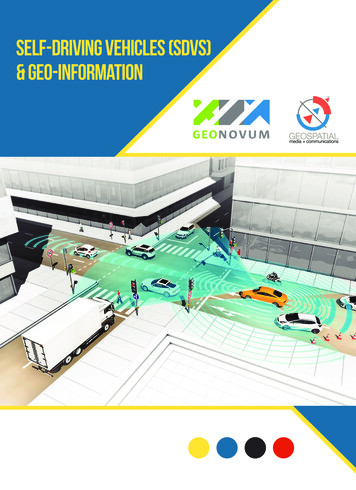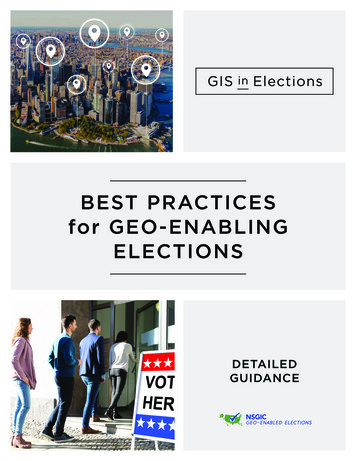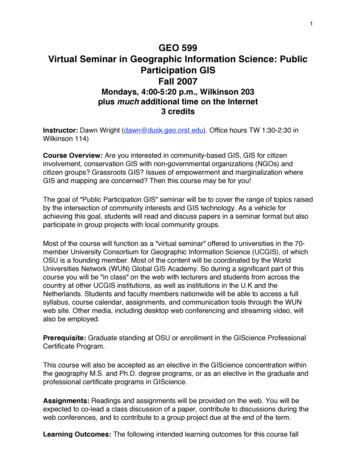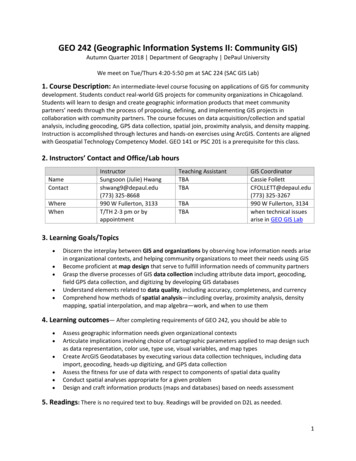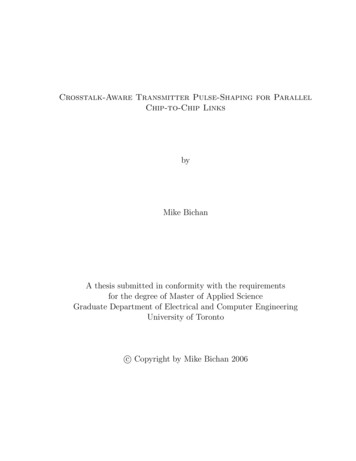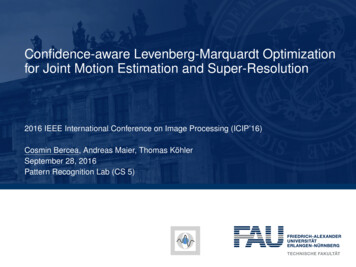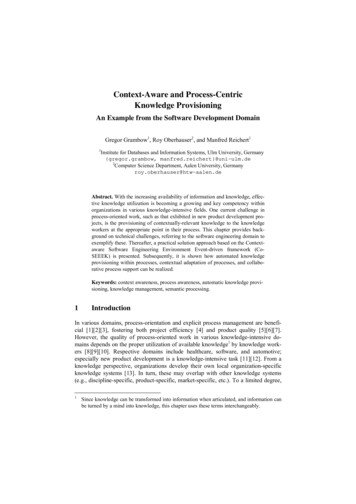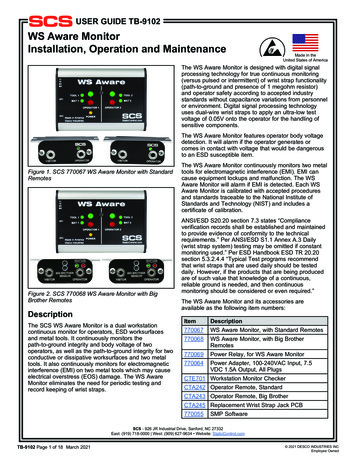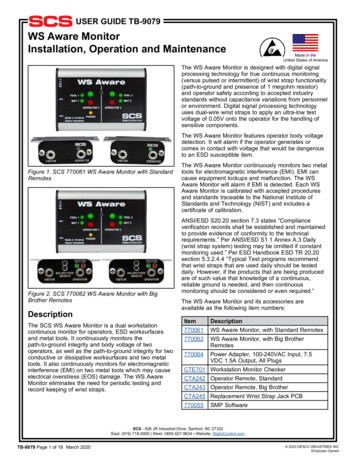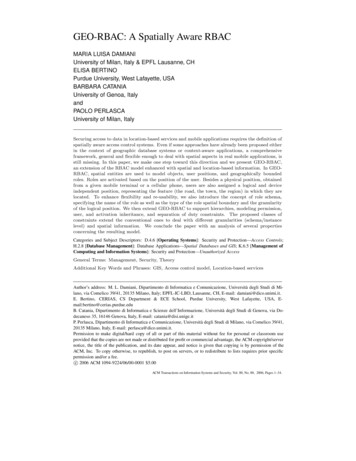
Transcription
GEO-RBAC: A Spatially Aware RBACMARIA LUISA DAMIANIUniversity of Milan, Italy & EPFL Lausanne, CHELISA BERTINOPurdue University, West Lafayette, USABARBARA CATANIAUniversity of Genoa, ItalyandPAOLO PERLASCAUniversity of Milan, ItalySecuring access to data in location-based services and mobile applications requires the definition ofspatially aware access control systems. Even if some approaches have already been proposed eitherin the context of geographic database systems or context-aware applications, a comprehensiveframework, general and flexible enough to deal with spatial aspects in real mobile applications, isstill missing. In this paper, we make one step toward this direction and we present GEO-RBAC,an extension of the RBAC model enhanced with spatial and location-based information. In GEORBAC, spatial entities are used to model objects, user positions, and geographically boundedroles. Roles are activated based on the position of the user. Besides a physical position, obtainedfrom a given mobile terminal or a cellular phone, users are also assigned a logical and deviceindependent position, representing the feature (the road, the town, the region) in which they arelocated. To enhance flexibility and re-usability, we also introduce the concept of role schema,specifying the name of the role as well as the type of the role spatial boundary and the granularityof the logical position. We then extend GEO-RBAC to support hierarchies, modeling permission,user, and activation inheritance, and separation of duty constraints. The proposed classes ofconstraints extend the conventional ones to deal with different granularities (schema/instancelevel) and spatial information. We conclude the paper with an analysis of several propertiesconcerning the resulting model.Categories and Subject Descriptors: D.4.6 [Operating Systems]: Security and Protection—Access Controls;H.2.8 [Database Management]: Database Applications—Spatial Databases and GIS; K.6.5 [Management ofComputing and Information Systems]: Security and Protection—Unauthorized AccessGeneral Terms: Management, Security, TheoryAdditional Key Words and Phrases: GIS, Access control model, Location-based servicesAuthor’s address: M. L. Damiani, Dipartimento di Informatica e Comunicazione, Università degli Studi di Milano, via Comelico 39/41, 20135 Milano, Italy; EPFL-IC-LBD, Lausanne, CH, E-mail: damiani@dico.unimi.it.E. Bertino, CERIAS, CS Department & ECE School, Purdue University, West Lafayette, USA, Email:bertino@cerias.purdue.eduB. Catania, Dipartimento di Informatica e Scienze dell’Informazione, Università degli Studi di Genova, via Dodecaneso 35, 16146 Genova, Italy, E-mail: catania@disi.unige.itP. Perlasca, Dipartimento di Informatica e Comunicazione, Università degli Studi di Milano, via Comelico 39/41,20135 Milano, Italy, E-mail: perlasca@dico.unimi.it.Permission to make digital/hard copy of all or part of this material without fee for personal or classroom useprovided that the copies are not made or distributed for profit or commercial advantage, the ACM copyright/servernotice, the title of the publication, and its date appear, and notice is given that copying is by permission of theACM, Inc. To copy otherwise, to republish, to post on servers, or to redistribute to lists requires prior specificpermission and/or a fee.c 2006 ACM 1094-9224/06/00-0001 5.00 ACM Transactions on Information Systems and Security, Vol. 00, No. 00, 2006, Pages 1–34.
2·M.L. Damiani et al.1. INTRODUCTIONThe widespread deployment of location-based services and mobile applications as wellas the increased concern for the management and sharing of geographical information instrategic applications like environmental protection and homeland security have resultedin a strong demand for spatially aware access control systems. These application domainspose interesting requirements against access control systems. In particular, the permissions assigned to users depend on their position in a reference space; objects to whichpermissions must be granted are located in that space; access control policies must takeinto account object locations and user positions. Moreover, as in many other applicationdomains, users often belong to well defined categories.As an example consider a mobile application for the personnel and patients of a healthcare organization. Individuals are given a location-aware terminal with which they canrequest information services provided by an application server. The organization consistsof individuals who have different functional roles, e.g. Nurse, Doctor and Patient. Depending of the organizational context, the services available to users may differ based onthe functional roles of users. For example, the services available to doctors may be different from those available to nurses, not simply because of the individual preferences butmainly because of organizational and functional reasons. Further, the availability of rolesand thus of services may depend on the position of the requester. For example, a doctormay be allowed to request the record of a patient only when located in the department shehas been assigned to. Moreover roles may be related to each other by a precedence relationship having a spatial meaning. For example, a doctor is also a member of the personnelof the organization and as such can be authorized to access additional services when located within the boundaries of the hospital in which the doctors’ departments are located.Furthermore, conflicts of interest might raise between roles, because of the position ofindividuals. For example, a doctor should not to allowed to be a manager in the same hospital, thus in the same location. To deal with such requirements, an access control modelwith spatial capabilities is needed. Since in location-aware applications users are oftengrouped in distinct categories, like nurse and doctor, role-based access control (RBAC)models [Ferraiolo et al. 2001; Sandhu et al. 2000] represent a reasonable choice. Variousrole-based and spatially aware access control systems have been proposed for securing access to spatial data stored in a spatial DBMS or for securing access to location-aware applications. Even though some preliminary proposals have been reported enhancing to accesscontrol mechanisms with contextual information, such as spatial and temporal information, such approaches are simplistic and do not account for several of the requirements wehave devised such as multigranularity of position and relationships in space. In this paper,we overcome those limitations by proposing a comprehensive spatial framework for anaccess control system securing access to spatial data in location-aware applications. Sucha model, called GEO-RBAC, extends the RBAC model with the concept of spatial roleand supports the homogeneous representation of all spatial aspects involving roles, objectsand contextual information such as user position. The spatial model we adopt is compliantwith OGC (Open GeoSpatial Consortium) [Open GIS Consortium 1999]. Thus, it is basedon the notion of feature type (a road, a town, a region) and feature, that is, an instance ofACM Transactions on Information Systems and Security, Vol. 00, No. 00, 2006.
GEO-RBAC: A Spatially Aware RBAC·3a given feature type (road A10, Milan, Lombardy). Features have a well defined geometry (representing points, lines, or polygons) in a reference space. Objects in GEO-RBACcorrespond to sets of features of a given type.A spatial role in GEO-RBAC represents a geographically bounded organizational function. The boundary is defined as a feature, such as a road, a city or a hospital. The boundaryspecifies the spatial extent in which the user is to be located for being enabled to play sucha role. Besides a physical position, obtained from a given mobile terminal such as a GPSbased vehicle tracking device or a cellular phone, users are also assigned a logical anddevice independent position, representing the feature in which the user is located. Logical positions can be computed from real positions by using specific mapping functions.To enhance the flexibility of the model, we assume that logical positions can be represented at different granularities, depending on the spatial role played by the user. If theuser is located inside the spatial boundary of the role which has been selected (activated)during the session she has logged in, the role is said to be enabled. To specify the typeof the spatial boundary of the role and the granularity of the logical position, we introduce the concept of spatial role schema. Spatial roles are thus specified as instances ofrole schemas. The usage of role schemas and instances makes our model quite flexiblesince the type of role extents and logical positions can be customized (and the definitionre-used), depending on the function the role represents. GEO-RBAC is a comprehensivemodel, which like RBAC, consists of three components referred to as Core, Hierarchicaland Constrained GEO-RBAC which are presented in this paper. The contributions of ourwork can be summarized as follows:—Core GEO-RBAC specifies the basic concepts of the model, thus the notion of spatialrole, role schema, real/logical position, activated/enabled role, which are used by thesubsequent components.—Hierarchical GEO-RBAC extends the conventional concept of hierarchy by introducingtwo major novelties. First, two distinct hierarchies are provided, one over role schemasand one over role instances. The role schema hierarchy supports the inheritance ofpermissions and user memberships among sets of homogeneous roles and thus furthersimplifies role definition. The second extension concerns the formal definition of roleactivation and enabling in the presence of hierarchies. To this purpose, we present amodel in which the role instance hierarchy is used to derive the roles which not only areactivated but also enabled in a session.—Constrained GEO-RBAC supports the specification of separation of duty (SoD) constraints for spatial roles and role schemas. Since exclusive role constraints are importantto support the definition and maintenance of access control policies in mobile contexts,SoD constraints are extended to account for different granularities (schema/instancelevel), dimension (spatial/non-spatial), and different verification time (static, dynamicat activation time, dynamic at enabling time). The resulting set of constraints representsthe first comprehensive class of constraints for spatially-aware applications.—Properties of Constrained GEO-RBAC. Even if the investigation of administrative operations for GEO-RBAC is outside the goals of this paper, an analysis on the expressivityand the complexity of the proposed constraints is a relevant issue in order to establishthe usability of the proposed model. Some of such properties extend already known results to the new classes of constraints we have introduced. Other properties are new andaccount for the specific characteristics GEO-HRBAC.ACM Transactions on Information Systems and Security, Vol. 00, No. 00, 2006.
4·M.L. Damiani et al.The remainder of this paper is organized as follows. In Section 2, we discuss relatedwork. The reference geometric model we consider in this paper and its usage in GEORBAC are introduced in Section 3. In Section 4, we present the core model of GEORBAC whereas hierarchies are discussed in Section 5. An overall example is presented inSection 6, which is then used in Section 7 to discuss the proposed classes of constraints.Properties of the resulting model are then discussed in Section 8. Finally, Section 9 presentssome concluding remarks and outlines future work. The Appendix contains proofs ofresults.2. RELATED WORKRelated research spans across several fields, from security to GIS (Geographical Information Systems) to context-based processing and mobile applications. The basis of ourapproach is the RBAC model which, since the seminal paper of Sandhu et al. [1996], hasgained increasingly consensus in the research community as well as in industry to finallybecome a standard widely adopted by organizations.By contrast, the concern for the integration of the spatial dimension into RBAC-basedmodels has emerged only recently as a consequence of the growing relevance of geo-spatialinformation in advanced GIS and mobile applications. In GIS, the demand for spatiallyaware access control systems is primarily motivated by the need of sharing geographicalinformation across local and national boundaries. To our knowledge, the first access control model for geographical data has been proposed in [Atluri and Mazzoleni 2002; Chunand Atluri 2000] to control access to satellite image maps. An access control system forgeometric and vector-based spatial data has been proposed in [Bertino et al. 2004]. Themodel introduces the concept of spatial authorization as an authorization that can be defined only on portions of space. When an access request is made for an object, the systemchecks whether the requested object lies in the authorization space and if this is the case,it grants the access. This model has been applied to support controlled access to spatialdata on the Web. The underlying spatial data model is, however, relatively simple anddoes not address important issues such as the multi-granularity of spatial data. A similararchitecture, but focused on XML-based representation of spatial data, has been proposedin [Purevjii et al. 2004]. A more complex spatial data model has been assumed in [Belussiet al. 2004]. In this work, an access control system is developed that allows the specification of authorization rules to control access to complex structured spatial data stored ina DBMS and organized according to multiple spatial representation levels and at multiplegranularities. The system, however, does not deal with geographically bounded roles neither with mobile users. An approach which integrates geo-spatial and security standards tosupport controlled access to spatial information through geo-Web services is presented in[Matheus 2005]. In this work, a policy specification language GeoXACML is defined as ageo-spatial extension of the OASIS standard eXtensible Access Control Markup Language(XACML). GeoXACML allows the specification of rules which enable or deny the accessto geo-spatial objects based on spatial criteria, such as containment relationships. None ofthese models however is conceived for use in a dynamic environment, which instead is themain concern of spatial and non-spatial context aware access control models.Non-spatial context-aware access control models include Generalized TRBAC (GTRBAC) [Joshi et al. 2005] which incorporates a set of language constructs for the specification of various temporal constraints on roles, including constraints on role enabling,ACM Transactions on Information Systems and Security, Vol. 00, No. 00, 2006.
GEO-RBAC: A Spatially Aware RBAC·5role activation, user-to-role assignments, and permission-to-role assignments. We borrowfrom this model the distinction between role enabling and activation. X-GTRBAC [Bhattiet al. 2005] augments GTRBAC with XML for supporting the policy enforcement in a heterogeneous, distributed environment. In addition to temporal constraints, the model alsosupports non-temporal contextual constraints. The approach, however, is more focused onthe software engineering aspects of the access control rather than on the expressivity of thepolicy specification language. A notable approach is the one proposed through the Generalized RBAC (GRBAC) [Covington et al. 2001; Covington et al. 2000]. GRBAC introducesthe concept of environment roles, that is, roles that can be activated based on the value ofconditions in the environment where the request has been made. Environmental conditionsinclude time, location, and other contextual information that is relevant to access control.If compared with GEO-RBAC, the concepts of role extent and user position are close tothat of context variables. However, the mechanism of context is very general and does notaccount for the specificity of spatial information, such as the multi-granularity of positionand the spatial relationships that may exist between the spatial elements in space. Moreover, in GEO-RBAC a common spatial data model is adopted in order to provide a uniformand standard based representation of locational aspects that, notably, involve not only rolesbut also protected objects. The spatial dimension of access control is the basic ingredientof the approach presented in [Hansen and Oleshchuk 2003a; 2003b]. In such work, anextension of RBAC model is proposed based on the notion of spatial role, intended as arole that is automatically activated when the user is in a given position. The space modelis however very simple and targeted to wireless network applications. It consists of a setof adjacent cells and the position of the user is the cell or the aggregate of cells containingit. The spatial granularity of the position is thus fixed while the space is rigidly structuredand the position itself does not have any semantic meaning but simply a geometric value.By contrast, in our model the granularity of the user position may depend on the role ofthe user; thus no assumption is made on the space layout. Moreover, the spatial dimension integrates geometric and semantic knowledge about the world. A different approachwhich combines space and time is presented in [Chandran and Joshi 2005]. Such systemborrows from GEO-RBAC the distinction between real position and logical position andfrom GTRBAC the notion of temporal context. Though, the model does not include thenotion of schema, neither supports important features of GEO-RBAC such as hierarchiesof enabled roles and spatially-aware separation of duty constraints.3. SPATIAL INFORMATION IN GEO-RBACIn order to make RBAC spatially aware, we need to first introduce the reference geometricmodel we want to use. In GEO-RBAC, the geometric model is used to represent objects,to model user positions, and to assign spatial extents to roles.3.1 The reference geometric modelThe geometric model describes how locations on Earth are represented in GEO-RBAC.We assume objects to be embedded in the Euclidean space E whilst a spatial referencesystem maps locations in E onto places on Earth. We assume objects to have a geometricrepresentation (geometry) compliant with the OGC (Open GeoSpatial Consortium) simplefeature geometric model [Open GIS Consortium 1999]. We adopt this model because itis widely deployed in commercial spatial DBMSs and GISs. Although a more advancedspatial data model has been recently proposed [Open GIS Consortium 2001; 2003], we doACM Transactions on Information Systems and Security, Vol. 00, No. 00, 2006.
6·M.L. Damiani et al.not lose in generality by adopting the simple feature model.In such a model, the geometry of an object can be of type point, line or polygon, orrecursively be a collection of disjoint geometries. A point describes a single location in thecoordinate space; a line represents a linear interpolation of an ordered sequence of points; apolygon is defined as an ordered sequence of closed lines defining the exterior and interiorboundaries of an area. An interior boundary defines a hole in the polygon.In GEO-RBAC, we consider the set of all geometries contained in a reference space(a polygon) and we denote it with GEO. We denote with M BB the reference space.Geometries can be related by different types of relationship. Among them, the referenceset of topological relations is REL {Disjoint, T ouch, In, Contains, Equal, Cross,Overlap}. These relations are binary, mutually exclusive (if one is true, the others arefalse) and they are a refinement of the well-known set of topological relations proposed byClementini et al. [1993]. To exemplify, the Contains(x, y) relationship between geometries x and y holds when all points of y are also points of x.3.2 Spatially
Author’s address: M. L. Damiani, Dipartimento di Informatica e Comunicazione, Universit a degli Studi di Mi-lano, via Comelico 39/41, 20135 Milano, Italy; EPFL-IC-LBD, Lausanne, CH, E-mail: damiani@dico.unimi.it. . For example, a doctor should not to allowed to be a manager in the same ho

